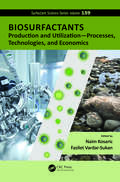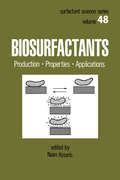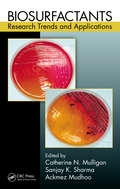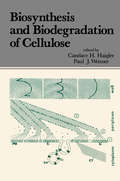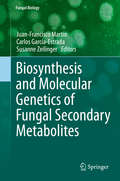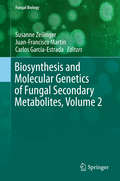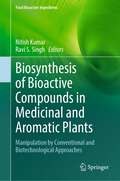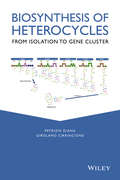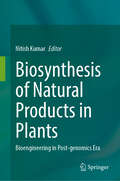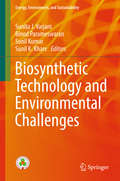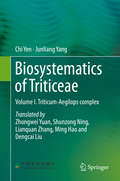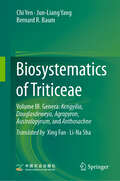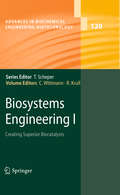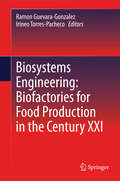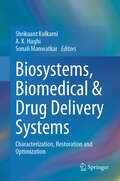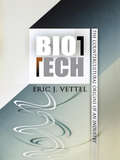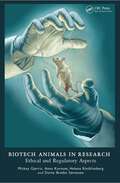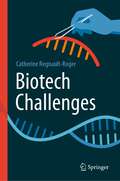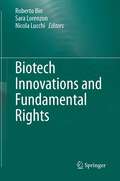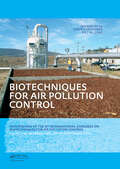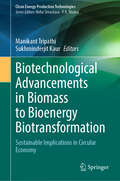- Table View
- List View
Biosurfactants: Microbial Surfactants
by Deepansh SharmaThis book illustrates the importance and significance of the biosurfactants obtained from microorganisms, preferably from bacteria and yeast. It explains the superiority of biosurfactants (green molecule) over chemically synthesized surfactants for the sustainable future. The content of the present book addresses the quest for novel biosurfactants producing strains, high throughput screening methods, and production strategies. It finely describes the aptness of biosurfactants for industrial and environmental applications. It elaborately describes the technical background and cutting-edge advancement of the commercial aspect of biosurfactants. In the later part of the book, the role of green biosurfactants in food processing, control of food spoilage, incorporation in personal health care products, environmental and agricultural remediation are discussed. Finally, the book elucidates a comprehensive and representative description of toxicity assessment of the biosurfactants, which highlights the risk assessment of the incorporation of the microbial biosurfactants in food, healthcare, and pharmaceutical formulations.
Biosurfactants: Production and Utilization-Processes, Technologies, and Economics (Surfactant Science)
by Fazilet Vardar-Sukan Naim KosaricStresses the Potential Applications of Biosurfactants in Various IndustriesEnvironmental concerns and a demand for sustainable chemical production have become important issues in recent years. As a result, microbial biosurfactant-producing systems are gaining momentum as potential replacements for chemical surfactants. Biosurfactants: Production an
Biosurfactants: Production: Properties: Applications
by Naim KosaricProviding comprehensive discussions of the physical and chemical properties, manufacture, and industrial uses of biosurfactants, this reference offers first-hand accounts of biosurfactant research of leading biotechnology laboratories. It introduces promising possible uses of biosurfactants in medicine, in environmental control, and for marine
Biosurfactants: Research Trends and Applications
by Ackmez Mudhoo Sanjay K. Sharma Catherine N. MulliganMicrobially derived surfactants, called biosurfactants, provide a promising alternative to synthetic surfactants, displaying better availability and being generally nontoxic and biodegradable. Biosurfactants also have the advantage of diverse chemical properties and the potential to be less expensive. They demonstrate properties such as reducing su
Biosynthesis and Biodegradation of Cellulose
by Candace H. HaiglerA gathering of articles bringing together knowledge of both the synthesis and degradation of a pervasive biological substance, cellulose. Topics include native cellulose; particle rosettes and terminal globules; microfibril biogenesis; synthesis in Acetobacter xylinum ; biodegradation measurement; e
Biosynthesis and Molecular Genetics of Fungal Secondary Metabolites (Fungal Biology)
by Susanne Zeilinger Juan-Francisco Martín Carlos García-EstradaThis volume describes the more relevant secondary metabolites of different fungi with current information on their biosynthesis and molecular genetics. Bolstered with color illustrations and photographs, the book describes the possible application of molecular genetics to directed strain improvement in great detail. The needs for future developments in this field are also discussed at length Written by authorities in the field, Biosynthesis and Molecular Genetics of Fungal Secondary Metabolites provides a cutting-edge perspective on fungal secondary metabolism and underlying genetics and is a valuable resource for scientists, researchers, and educators in the field of fungal biology.
Biosynthesis and Molecular Genetics of Fungal Secondary Metabolites, Volume 2 (Fungal Biology)
by Susanne Zeilinger Juan-Francisco Martín Carlos García-EstradaFungi produce many chemically diverse secondary metabolites whose biological roles largely remain elusive. Within the increasing number of sequenced fungal genomes several important genes involved in secondary metabolite formation have been identified. Most of these genes are clustered and their coordinated transcription is controlled in a complex way by both narrow pathway-specific regulators as well as broad global transcription factors responsive to environmental cues. In recent years it was discovered many of the newly identified gene clusters are silent under laboratory conditions suggesting that the biosynthetic potential of fungi is far from being exploited. Besides identifying novel bioactive metabolites from still unexplored sources, the activation of these gene clusters by several approaches may result in the discovery of new substances with antibiotic and pharmaceutical benefits. This book covers recent advances in the field of fungal secondary metabolisms ranging from methodologies to biological aspects and will include the latest knowledge on fungal molecular biology, genomics, and metabolomics. With the related volume by Professor Juan-Francisco Martin, where the most relevant and well-studied fungal secondary metabolites are compiled, this book provides a comprehensive overview of the state-of-the-art of research on fungal secondary metabolites.
Biosynthesis of Bioactive Compounds in Medicinal and Aromatic Plants: Manipulation by Conventional and Biotechnological Approaches (Food Bioactive Ingredients)
by Nitish Kumar Ravi S. SinghPlant bioactive compounds are plant-based natural products that display a variety of pharmacological applications. These bioactive compounds are important as medicines, pigments and flavorings since most of the pharmaceutical industries are highly dependent on medicinal plants and their extraction. The types and concentrations of bioactive compounds produced by plants are determined by the species, genotype, physiology, developmental stage and environmental factors during growth, determining the physiological adaptive responses employed by various plant taxonomic groups in coping with the stress and defensive stimuli. In the past two decades there has been a renewed interest in the study of conventional aspects such as elicitors and biotic and abiotic stress factors that influence secondary metabolism during in vitro and in vivo growth of plants. the application of molecular biology tools and techniques are facilitating increased understanding of the signaling processes and pathways involved in the bioactive compounds production in subcellular, cellular, organ and whole plant systems during in vivo and in vitro growth, with application in the metabolic engineering of biosynthetic pathways intermediates. Biosynthesis and Manipulation of Bioactive compounds in Medicinal and Aromatic Plants provides a comprehensive introduction and review of the state-of-the-art biotechnological tools used in enhancement of bioactive compounds in medicinal and aromatic plants. Readers will find a systematic overview of techniques such as Omics, Crisper /Cas9 and RNAi to enhance plant bioactive contents including various in vitro techniques, hairy root culture and transgenic technology to enhance plant bioactive contents using plant tissue culture approaches. The chapters provide an overview of the role of induced mutation, biotic and abiotic stress to increase the bioactive contents in plants, plus the role of endophytes to enhance the contents of plant bioactive compounds and standard operating procedures using hydroponics system of cultivation for significant enhancement of bioactive compounds.This book serves as a single source for researchers working in plant secondary metabolites and the pharmaceutical industry.
Biosynthesis of Heterocycles
by Patrizia Diana Girolamo CirrincioneThis book describes biosynthetic methods to synthesize heterocyclic compounds, offering a guide for the development of new drugs based on natural products. The authors explain the role of natural products in chemistry and their formation along with important analytical methods and techniques for working with heterocycles.* Covers methods and techniques: isotopic labelling, enzymes and mutants, and pathway identification* Provides a thorough resource of information specifically on heterocyclic natural products and their practical biosynthetic relevance* Explains the role of natural products in chemistry and their formation* Discusses gene cluster identification and the use of biogenetic engineering in pharmaceutical application
Biosynthesis of Natural Products in Plants: Bioengineering in Post-genomics Era
by Nitish KumarThis book discusses the importance of plants in terms of their natural bioactive products and medicinal, nutraceutical and health benefits. Plants are natural sources of many pharmaceutical compounds used in traditional and modern medicine, and their mass production and efficient use is imperative in view of the new emerging diseases. This book covers breakthroughs in the research of plant natural products by focusing on how different state-of-the-art biotechnologies facilitate their discovery, the molecular basis of their biosynthesis, as well as synthetic biology. Research on plant's natural products in the pre-genomic era was focused on discovering bioactive molecules with pharmaceutical activities, and identifying individual genes responsible for biosynthesis. In the post-genomics era, however, integration of inter-disciplinary approaches and detailed analysis of all accessible data from multi-informatics is necessary. This would accelerate the full characterization of biosynthetic and regulatory circuit for producing plant natural products.This book is an important reference book for the researchers working in the field of plant natural products and pharmaceutical industries at global level.
Biosynthetic Technology and Environmental Challenges (Energy, Environment, and Sustainability)
by Sunil Kumar Sunita J. Varjani Binod Parameswaran Sunil K. KhareThis book provides a comprehensive review of biosynthetic approaches to the production of industrially important chemicals and the environmental challenges involved. Its 19 chapters discuss different aspects of biosynthetic technology from the perspective of leading experts in the field. It covers various biorefinery approaches, including the use of microbes, metabolically engineered plants, biomass-based and green technology methods. Further, it examines important research in the areas of organic and hazardous waste composting, management and recovery of nutraceuticals from agro-industrial waste, biosynthesis and technological advancements of biosurfactants and waste water bioremediation. This book contributes to the scientific literature on biosynthetic technologies and the related environmental challenges for researchers and academics working in this area around the globe.
Biosystematics of Triticeae: Volume I. Triticum-Aegilops complex
by Chi Yen Junliang YangThis book discusses the natural classification and biosystematics of Triticeae, and presents the most significant findings of comprehensive studies on the Triticeae, an important tribe in the grass family (Poaceae) that includes major crops such as wheat, barley, rye and triticale, as well as various forage crops found in different genera. The five-volume Chinese version of Biosystematics of Triticeae was published in 1998, 2004, 2006, 2011, and 2013, and included the 30 genera, 2 subgenera, 464 species, 9 subspecies, and 186 varieties of Triticeae identified to date. This completely revised English edition features up-to-date international research and the latest advances in the field. The book is divided into five volumes, covering a wide range of disciplines from traditional taxonomy and cytogenetics, to molecular phylogeny. Volume I, Triticum-Aegilops complex focuses on the taxonomy and generic relationships of Triticum and Aegilops, discussing the origin of common wheat as a crop. Volume II highlights the taxonomy and systematics of Secale, Tritiosecale, Pseudosecale, Eremopyrum, Henrardia, Taeniantherum, Heteranthelium, Crithopsis, and Hordeum.Volume III describes perennial genera and species including Kengyilia, Douglasdeweya, Agropyron, Australopyrum, and Anthosachne. Volume IV addresses perennial genera and species including Stenostachys, Psathyrostachys, Leymus, Pseudoroegneria, and Roegeneria. Volume V presents perennial genera and species such as Campeiostachys, Elymus,Pascopyrum, Lophopyrum, Trichopyrum, Hordelymus, Festucopsis, Peridictyon, and Psammopyrum.
Biosystematics of Triticeae: Volume II. Genera: Secale, Tritiosecale, Pseudosecale, Eremopyrum, Henrardia, Taeniantherum, Heteranthelium, Crithopsis, and Hordeum
by Chi Yen Junliang YangThis book discusses the natural classification and biosystematics of Triticeae and presents the most significant findings of comprehensive studies on the Triticeae, an important tribe in the grass family (Poaceae) that includes major crops such as wheat, barley, rye, and triticale, as well as various forage crops found in different genera. The five-volume Chinese version of Biosystematics of Triticeae was published in 1998, 2004, 2006, 2011, and 2013, and included the 30 genera, two subgenera, 464 species, nine subspecies, and 186 varieties of Triticeae identified to date. This is their English edition. The book is divided into five volumes, covering a wide range of disciplines from traditional taxonomy and cytogenetics to molecular phylogeny. Volume I, Triticum-Aegilops complex focuses on the taxonomy and generic relationships of Triticum and Aegilops, discussing the origin of common wheat as a crop. Volume II, Genera: Secale, Tritiosecale, Pseudosecale, Eremopyrum, Henrardia, Taeniantherum, Heteranthelium, Crithopsis, and Hordeum highlights a number of genera that are closely related based on their morphological classification and that contain only one unique genome. Volume III describes perennial genera and species including Kengyilia, Douglasdeweya, Agropyron, Australopyrum, and Anthosachne. Volume IV addresses perennial genera and species including Stenostachys, Psathyrostachys, Leymus, Pseudoroegneria, and Roegeneria. Volume V presents perennial genera and species such as Campeiostachys, Elymus, Pascopyrum, Lophopyrum, Trichopyrum, Hordelymus, Festucopsis, Peridictyon, and Psammopyrum.
Biosystematics of Triticeae: Volume III. Genera: Kengyilia, Douglasdeweya, Agropyron, Australopyrum, and Anthosachne
by Chi Yen Jun-Liang Yang Bernard R. BaumThis book discusses the natural classification and biosystematics of Triticeae and presents the most significant findings of comprehensive studies on the Triticeae, an important tribe in the grass family (Poaceae) that includes major crops such as wheat, barley, rye, and triticale, as well as various forage crops found in different genera. The five-volume Chinese version of Biosystematics of Triticeae was published in 1998, 2004, 2006, 2011, and 2013, and included the 30 genera, two subgenera, 464 species, nine subspecies, and 186 varieties of Triticeae identified to date. This is their English edition. The volumes cover a wide range of disciplines from traditional taxonomy and cytogenetics to molecular phylogeny. They are designed for biologists, plant breeders, taxonomists, geneticists, biogeographic researchers, historians, biotechnologists, agriculturalists, and evolutionists. Volume I, Triticum-Aegilops complex focuses on the taxonomy and generic relationships of Triticum and Aegilops, discussing the origin of common wheat as a crop. Volume II, Genera: Secale, Tritiosecale, Pseudosecale, Eremopyrum, Henrardia, Taeniantherum, Heteranthelium, Crithopsis, and Hordeum highlights a number of genera that are closely related based on their morphological classification and that contain only one unique genome. Volume III describes perennial genera and species including Kengyilia, Douglasdeweya, Agropyron, Australopyrum, and Anthosachne. Volume IV addresses perennial genera and species including Stenostachys, Psathyrostachys, Leymus, Pseudoroegneria, and Roegeneria. Volume V presents perennial genera and species such as Campeiostachys, Elymus, Pascopyrum, Lophopyrum, Trichopyrum, Hordelymus, Festucopsis, Peridictyon, and Psammopyrum.
Biosystematics of Triticeae: Volume V. Genera: Campeiostachys, Elymus,Pascopyrum, Lophopyrum, Trichopyrum, Hordelymus, Festucopsis, Peridictyon, and Psammopyrum
by Chi Yen Junliang YangThis book review and rearrange the research data of Triticeae published over hundreds of years, applying a modern scientific approach. Triticeae is an important tribe in the grass family (Peaceae). It includes the major cereal crops, such as wheat, barley and rye, in addition to many valuable forage crops found in different genera, such as Elymus, Agropyron, Pasthyrostachys, and Leymus. The knowledge of appropriate Triticeae taxonomy and biosystematics will serve as genetic breeding of wheat, barley, rye and forage grass. The authors attempted to remain the truth and remove the false for deriving a more natural biosystematics of Triticeae. This book covers taxonomy, cytogenetics, and molecular phylogeny. It summarizes the biosystematics of Triticeae with comprehensive and updated data. This book is divided into five volumes (Volumes 1- 5), and includes 30 genera, 2 subgenera, 464 species, 9 subspecies, and 186 varieties in Triticeae. Volume 5 introduces nine perennial genera in Triticeae: Campeiostachys, Elymus, Pascopyrum, Lophopyrum, Trichopyrum, Hordelymus, Festucopsis, Peridictyon, and Psammopyrum. Elymus (StH), Campeiostachys (StYH), Lophopyrum (E), and Trichopyrum (ESt)are polymorphic genus. They show similar morphological characters, and it is difficult to distinguish them based merely on morphological variation. Pascopyrum (StHNsXm), Hordelymus (XoXr), Festucopsis (L), Peridictyon (Xp), and Psammopyrum (EL) are small genera, mostly monotypic genera. This book can serve as highly qualified, valuable, and convenient handbooks for audiences who are interested in Triticeae. This book also includes many illustrations, in addition to the description, to help the audience understand, morphological features of the concerned taxa, which makes the explanation more precise and obvious. It is a useful tool to understand the relationship among species in Triticeae.
Biosystems Engineering II: Creating Superior Biocatalysts (Advances in Biochemical Engineering/Biotechnology #120)
by Christoph Wittmann Rainer Krull-Morphology of Filamentous Fungi: Linking Cellular Biology to Process Engineering Using Aspergillus niger, By Rainer Krull, Christiana Cordes, Harald Horn, Ingo Kampen, Arno Kwade, Thomas R. Neu, and Bernd Nörtemann; -Multi-Scale Spatio-Temporal Modeling: Lifelines of Microorganisms in Bioreactors and Tracking Molecules in Cells, By Alexei Lapin, Michael Klann, and Matthias Reuss; -Impact of Profiling Technologies in the Understanding of Recombinant Protein Production, By Chandran Vijayendran and Erwin Flaschel -Engineering the Escherichia coli Fermentative Metabolism, By M. Orencio-Trejo, J. Utrilla, M.T. Fernàndez-Sandoval, G. Huerta-Beristain, G. Gosset, and A. Martinez; -Modeling Languages for Biochemical Network Simulation: Reaction vs Equation Based Approaches, By Wolfgang Wiechert, Stephan Noack, and Atya Elsheikh; -Impact of Thermodynamic Principles in Systems Biology, By J.J. Heijnen;
Biosystems Engineering: Biofactories For Food Production In The Century Xxi (Advances In Biochemical Engineering & Biotechnology Ser. #Vol. 139)
by Ramon Guevara-Gonzalez Irineo Torres-PachecoThis book presents new food production systems (for plants and animals) involving agrochemicals that increase in a controlled manner the bioactives content, under greenhouse conditions. Moreover, conception and design of new instrumentation for precision agriculture and aquiculture contributing in food production is also highlighted in this book.
Biosystems, Biomedical & Drug Delivery Systems: Characterization, Restoration and Optimization
by A. K. Haghi Shrikaant Kulkarni Sonali ManwatkarThe book gives an insight into the thorough study and examination of incumbent biosystems, their present status and disruption in their integrity, causes and effects, measures to be taken for their characterization and restoration apart from advances and applications in the field of biosciences, drug design, discovery, bio-systems, biomedical and drug delivery technologies, tools in particular. The book collates information from several disciplines, such as chemistry, biology, material science, engineering, statistics, biomedicine, genetics, etc., as the subject in question is a confluence of many disciplines exhibiting numerous applications such as bioimaging, novel biological agents, synthesis, discovery testing, characterization of drugs right from selecting a suitable precursor to discovering and designing a drug following a correct synthetic route, adoption of computer simulation-based models, AI/ML-based models, application of statistical tools in analyzing and interpreting data, design, multi-functional, and operational drug delivery systems, their bio-compatibility, capacity of carrying and release of drug reproducibly etc. The book is helpful to postgraduate students, research scholars, academicians, and scientists from the pharmaceutical, biotechnology, and chemical engineering domains. The book covers a conceptual understanding of the exploration of drugs in unity with the applications desired, sound bio-system development, and carriers for drug and supplement delivery.
Biotech
by Eric J. VettelThe seemingly unlimited reach of powerful biotechnologies and the attendant growth of the multibillion-dollar industry have raised difficult questions about the scientific discoveries, political assumptions, and cultural patterns that gave rise to for-profit biological research. Given such extraordinary stakes, a history of the commercial biotechnology industry must inquire far beyond the predictable attention to scientists, discovery, and corporate sales. It must pursue how something so complex as the biotechnology industry was born, poised to become both a vanguard for contemporary world capitalism and a focal point for polemic ethical debate.In Biotech, Eric J. Vettel chronicles the story behind genetic engineering, recombinant DNA, cloning, and stem-cell research. It is a story about the meteoric rise of government support for scientific research during the Cold War, about activists and student protesters in the Vietnam era pressing for a new purpose in science, about politicians creating policy that alters the course of science, and also about the release of powerful entrepreneurial energies in universities and in venture capital that few realized existed. Most of all, it is a story about people--not just biologists but also followers and opponents who knew nothing about the biological sciences yet cared deeply about how biological research was done and how the resulting knowledge was used.Vettel weaves together these stories to illustrate how the biotechnology industry was born in the San Francisco Bay area, examining the anomalies, ironies, and paradoxes that contributed to its rise. Culled from oral histories, university records, and private corporate archives, including Cetus, the world's first biotechnology company, this compelling history shows how a cultural and political revolution in the 1960s resulted in a new scientific order: the practical application of biological knowledge supported by private investors expecting profitable returns eclipsed basic research supported by government agencies.
Biotech Animals in Research: Ethical and Regulatory Aspects
by Mickey GjerrisThis book explores central aspects of genetic modification of animals for scientific purposes in the context technological possibilities, regulatory issues in different regions, animal welfare implications and wider ethical issues exemplified through current theories and frameworks. This discussion of lab animals produced through modern biotechnologies becomes increasingly pressing as CRISPR-Cas9 technology advances rapidly, challenging legal and ethical frameworks all over the world. Such animals are now affordable and readily available to almost every branch of scientific research. This not only raises enormous potential for creating ‘tailored’ models for human diseases but also rubs up against the traditional guiding principles (the 3Rs) for the humane use of animals for scientific experiments and raises wider ethical issues around death, integrity and naturalness. In this book, expert authors from diverse backgrounds in laboratory animal care, animal research, technology and animal rights explore a range of topics, from the science behind biotech research animals and the regulation of their use, to utilitarian, animal rights, virtue ethics and ethics of care, and critical animal studiers' perspectives on the use of these technologies. Whatever your background or role in animal research, this book will challenge and stimulate deeper consideration of the benefits, disadvantages and ethical consequences of the use of biotechnology in the animal laboratory.
Biotech Challenges
by Catherine Regnault-RogerThe evolution of genome’s modification by genetic engineering was characterized by a major technological breakthrough with the discovery of CRISPR in 2012. A distinction is now made between first-generation biotechnologies developed in the 20th century and current second-generation biotechnologies, NGT or New Genomic Techniques, including genome editing. How do we consider these genomic modifications compared to those that occur spontaneously in nature? What are the applications of these techniques in the fields of plants, animals, and human health? What prospects in terms of development and independence for countries and at least what regulations are in force on the different continents?The book questions what GMOs are, genome editing products and the place of genomic transformations today and tomorrow in our societies. It tries to give some geostrategic and regulatory benchmarks on biotech products in order to better understand the current issues.
Biotech Innovations and Fundamental Rights
by Nicola Lucchi Roberto Bin Sara LorenzonBiotechnology is a recognized research area that has increasingly advanced into new technologies and modern practices raising several legal, ethical and regulatory issues. The revolutionary speed of biotech innovations has had a significant impact on the protection of the rights of the individual. Fundamental rights provide a framework within which the justification of limitations and restrictions to biotechnology innovations and research results have to be assessed. The legal regulation of scientific research and scientific investigations impact more and more directly on the freedom of research and therapies as well as on the broad diffusion of knowledge. Closely related is also the debated question of the technological manipulation of life and the boundary of scientific knowledge with regard to the topical question of genetic invention patents and their side effects on access to scientific information and health care opportunities. Drawing on expertise from different disciplines, the volume comprises invited papers and plenary presentations given at the conference entitled "Biotech Innovations & Fundamental Rights" that took place on Januray 20-21 2011 at the Department of Juridical Sciences of the University of Ferrara. Each contribution covers a different aspect of the legal and scientific issues involved in regulation of biotechnology. In particular the focus of attention has been given to genetic research, genetic data, freedom of scientific research in genetics and biotech patents.
Biotech Juggernaut: Hope, Hype, and Hidden Agendas of Entrepreneurial BioScience
by Tina Stevens Stuart NewmanBiotech Juggernaut: Hope, Hype, and Hidden Agendas of Entrepreneurial BioScience relates the intensifying effort of bioentrepreneurs to apply genetic engineering technologies to the human species and to extend the commercial reach of synthetic biology or "extreme genetic engineering." In 1980, legal developments concerning patenting laws transformed scientific researchers into bioentrepreneurs. Often motivated to create profit-driven biotech start-up companies or to serve on their advisory boards, university researchers now commonly operate under serious conflicts of interest. These conflicts stand in the way of giving full consideration to the social and ethical consequences of the technologies they seek to develop. Too often, bioentrepreneurs have worked to obscure how these technologies could alter human evolution and to hide the social costs of keeping on this path. Tracing the rise and cultural politics of biotechnology from a critical perspective, Biotech Juggernaut aims to correct the informational imbalance between producers of biotechnologies on the one hand, and the intended consumers of these technologies and general society, on the other. It explains how the converging vectors of economic, political, social, and cultural elements driving biotechnology’s swift advance constitutes a juggernaut. It concludes with a reflection on whether it is possible for an informed public to halt what appears to be a runaway force.
Biotechniques for Air Pollution Control: Proceedings of the 3rd International Congress on Biotechniques for Air Pollution Control. Delft, The Netherlands, September 28-30, 2009
by Christian Kennes Piet N.L. Lens Jan BartacekEnergy and feedstock materials for the chemical industry show an increasing demand. With constraints related to availability and use of oil, the energy and chemical industry is subject to considerable changes. The need for the use of cheaper and widely available feedstocks, and the development of sustainable and environmentally friendly c
Biotechnological Advancements in Biomass to Bioenergy Biotransformation: Sustainable Implications in Circular Economy (Clean Energy Production Technologies)
by Sukhminderjit Kaur Manikant TripathiThis edited volume focusses on the advancements in the production technologies, challenges and perspectives for converting wastes biomass to energy. It discusses sustainable solutions to contemporary challenges of simultaneous bioenergy production and waste management. One of the biggest environmental concerns today is waste generation and management due to the growing population and industrial expansion. Hazardous chemicals from industrial processes, agriculture, and the medical sector result in high pollution levels, contaminating water, air, and soil. This pollution poses a significant threat to the environment and human health. Advanced technologies using microorganisms, nanomaterials, and molecular approaches offer environmentally friendly solutions to these issues. Agro-wastes, including fruit and vegetable wastes, can be viable resources for green energy production, promoting greener and circular economic strategies. This book highlights advances in bioprocesses for a sustainable environment, energy production from waste, bioremoval of hazardous pollutants, meta-omics approaches, bio-based technologies for resource recovery, bioeconomy models, nano-biosensors, and bionanotechnology in waste site restoration. Readers will gain insights into recent sustainable progress and future applications of advanced biotechnological approaches to waste management. This book is highly recommended as reference literature for a diverse community of professionals, scientists, researchers, biotechnologists, environmentalists, industrialists, environmental biotechnologists, students (undergraduate and postgraduate), and innovators involved in developing strategies to address the challenges of current environmental issues.

